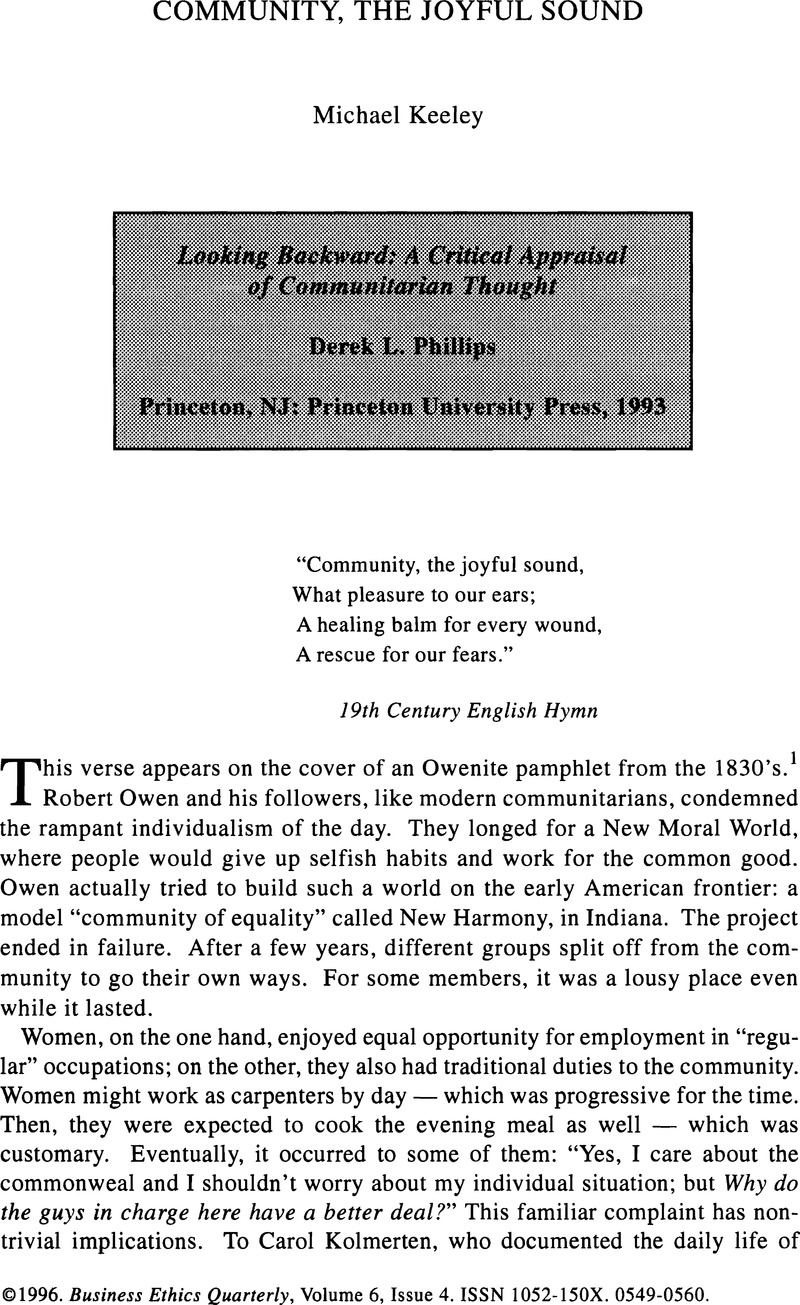No CrossRef data available.
Published online by Cambridge University Press: 23 January 2015

1 Harry, Howells Horton, “Community, The Only Salvation for Man,” reprinted in The Rational System: Seven Pamphlets, 1837-1841 (New York: Arno Press, 1972).Google Scholar
2 Carol, A. Kolmerten, Women in Utopia (Bloomington, IN: Indiana University Press, 1990), p. 2.Google Scholar
3 Derek, L. Phillips, Looking Backward: A Critical Appraisal of Communitarian Thought (Princeton, NJ: Princeton University Press, 1993).Google Scholar
4 For example, in Equality, Justice and Rectification (New York: Academic Press, 1979)Google Scholar and Toward a Just Social Order (Princeton, NJ: Princeton University Press, 1986).
5 Alasdair, Maclntyre, After Virtue, 2d ed. (Notre Dame, IN: University of Notre Dame Press, 1984), p. 133.Google Scholar
6 Ibid., p. 135.
7 See, e.g., Bernard, Bailyn, The Ideological Origins of the American Revolution (Cambridge, MA: Harvard University Press, 1965);Google ScholarPocock, J. G. A., The Machiavellian Moment (Princeton, NJ: Princeton University Press, 1975).Google Scholar
8 See, e. g., Joyce, Appleby, Liberalism and Republicanism in the Historical Imagination (Cambridge, MA: Harvard University Press, 1992);Google ScholarRichard, C. Sinopoli, The Foundations of American Citizenship (New York: Oxford University Press, 1992).Google Scholar
9 Edmund, S. Morgan, The Birth of the Republic, 1763-89, 3d ed. (Chicago: University of Chicago Press, 1992), p. 5.Google Scholar
10 John, Frederick Martin, Profits in the Wilderness (Chapel Hill, NC: University of North Carolina Press, 1991).Google Scholar
11 Phillips, Looking Backward, p. 69.
12 Ibid., pp. 67-68.
13 Ibid., p. 73.
14 Appleby, Liberalism and Republicanism in the Historical Imagination, p. 285.
15 Phillips, Looking Backward, p. 33. A still-informative description of the early Virginians has been provided by Sigmund, Diamond (“From Organization to Society: Virginia in the Seventeenth Century,” American Journal of Sociology, vol. 63 [1958], pp. 457–75).Google Scholar It seems the first settlers included almost as many “gentlemen” (then, a real occupational category) as laborers; this elicited from Captain John Smith the familiar lament that his organization (the Virginia Company) had too many bosses and not enough workers.
16 Phillips, Looking Backward, p. 77. Jefferson's rancor was directed at another republican icon, John Adams of Massachusetts, who later reflected that “there is an overweening fondness for representing this country as a scene of liberty, equality, fraternity, union, harmony and benevolence. But let not your sons or mine deceive themselves. This country, like all others, has been a theatre of parties and feuds for near two hundred years” (Adams to William Tudor, February 4, 1817; in Stephen, E. Patterson, Political Parties in Revolutionary Massachusetts [Madison, WI: University of Wisconsin Press, 1973], p. 7).Google Scholar
17 Ibid., p. 70.
18 Stephanie, Grauman Wolf, As Various as Their Land (New York: HarperCollins, 1994).Google Scholar
19 Robert, N. Bellah, Richard, Madsen, William, M. Sullivan, Ann, Swidler, and Steven, M. Tipton, Habits of the Heart (New York: Harper & Row, 1986), p. 291.Google Scholar
20 Wolf, As Various as Their Land, pp. 65-70.
21 Phillips, Looking Backward, p. 155.
22 For example, Amitai, Etzioni(The Spirit of Community [New York: Crown, 1993], p. 27)Google Scholar cites the following survey results:
Almost half of Americans surveyed report chronic malingering at work and calling in sick when they are not sick; one-sixth admit that they have abused drugs or alcohol while at work. Six out of ten (59 percent) admit to having used physical force against another person — and fewer than half (45 percent) regret it. Twenty-five percent of Americans say that they would abandon their families for money, and 7 percent admit freely that they would kill someone if paid enough.
Etzioni gets these statistics from a controversial opinion survey by a couple of advertising executives.
23 Edward, Bellamy, Looking Backward, 2000-1887 (New York: Penguin, 1982;Google Scholar original 1888).
24 Shelley, Burtt, “The Politics of Virtue Today: A Critique and a Proposal,” American Political Science Review (1993), 87: 360–368.Google Scholar
25 Phillips, Looking Backward, p. 20.
26 MacIntyre, After Virtue, p. 236.
27 References and relevant discussion can be found in Michael, Keeley, A Social-Contract Theory of Organizations (Notre Dame, IN: University of Notre Dame Press, 1988).Google Scholar
28 Will, Kymlicka, Liberalism, Community, and Culture (Oxford: Oxford University Press, 1989), p. 85.Google Scholar
29 Stephen, Holmes, The Anatomy of Antiliberalism (Cambridge, MA: Harvard University Press, 1993), pp. 176–177.Google Scholar
30 His lecture tour peaked with well publicized addresses in the new Capitol building to members of Congress, justices of the Supreme Court, and other distinguished guests (including President James Monroe and President-elect John Quincy Adams). Owen explained the evils of the “selfish individualistic system”; he shared his ideas for uniting persons in communities with “one common interest”; and he outlined his plans for a “community of equality” (complete with apartments featuring hot and cold running water and something like central heat and cooling). Owen was serious. He had just bought an entire town in wilds of Indiana. The town of New Harmony consisted of mills, workshops, homes and public buildings — all built by a religious sect who moved on and sold the place to Owen, lock, stock and barrel. A good history of the place is provided by Anne, Taylor, Visions of Harmony (Oxford: Oxford University Press, 1987).Google Scholar
31 Quotes are from Frank, Podmore, Robert Owen, A Biography (New York: Kelley, 1968; original 1906), pp. 291–293.Google Scholar